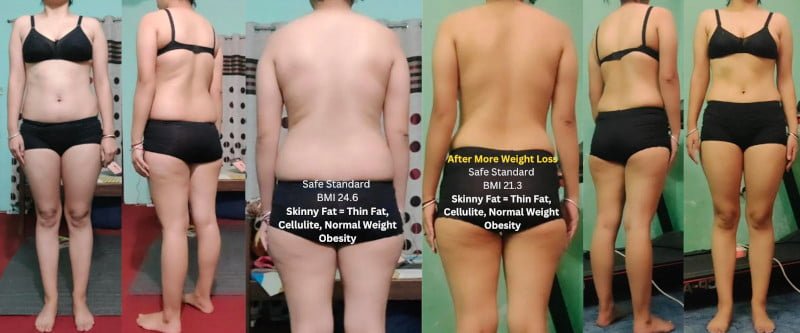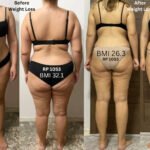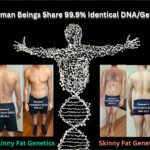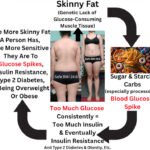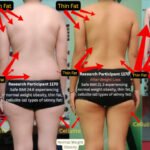What Body Fat Percentage Is Skinny Fat?
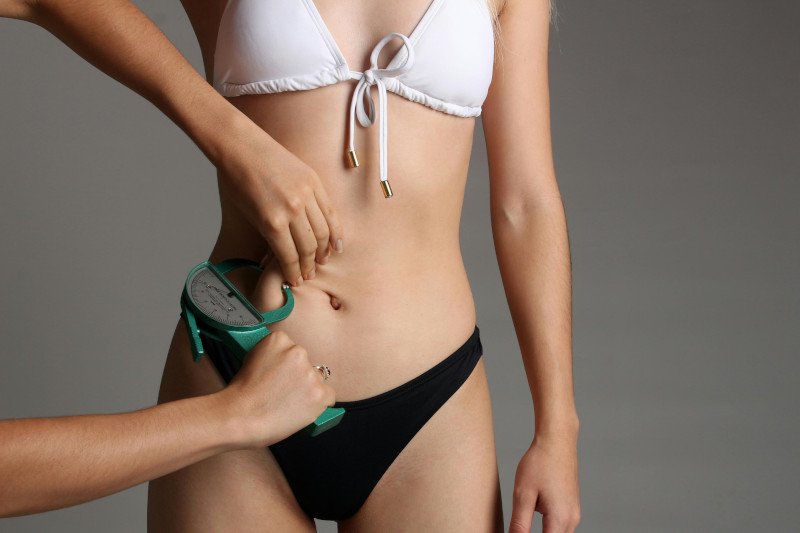
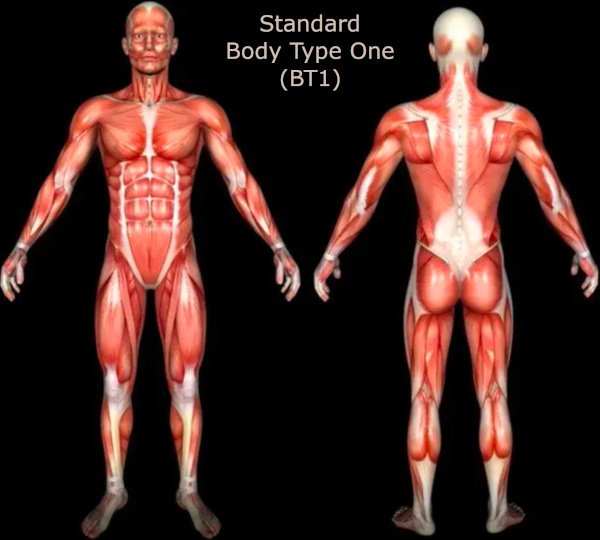 What body fat percentage is considered skinny fat? Genetically, there are 600+ muscles (1) in a fully developed human body. But, because of the inherent nature of genetics, some human bodies are less developed than others. People who are lacking developed genetic muscle tissue, to whatever degree, are experiencing skinny fat (2).
What body fat percentage is considered skinny fat? Genetically, there are 600+ muscles (1) in a fully developed human body. But, because of the inherent nature of genetics, some human bodies are less developed than others. People who are lacking developed genetic muscle tissue, to whatever degree, are experiencing skinny fat (2).
In 2016, the NIH released the first accepted scientific definition (3) of skinny fat — normal-weight obesity (NWO):
“Normal-weight obesity syndrome is characterized by excess body fat in individuals with adequate body mass index (18.5-24.9 kg/m(2)).”
The “excess body fat” referenced is regular white/yellow fat (body fat %, common adipose tissue). Because skinny fat science is so young, there was minimal scientific data then. Thus, that initial definition was merely that; initial. We had to start somewhere, but much more scientific research is certainly needed (see our MRI Study (30)).
What Body Fat Percentage Is Skinny Fat?
What that initial definition failed to clarify is, skinny fat is a lack of genetic muscle tissue (4, 5, 2). Contrary to widespread popular belief, skinny fat and regular white/yellow fat are two different things (6). You do not magically cure skinny fat by losing more regular fat. In fact, you can technically lose 100% of your regular fat, yet your skinny fat (lack of genetic muscle tissue) will remain. Regular fat and skinny fat are not the same.
Hence, body fat percentage does not determine if a person is or is not skinny fat. Instead, how much genetic muscle tissue determines skinny fat. So, then, how is muscle tissue measured to determine skinny fat? The only way to accurately measure muscle tissue (or lack of/skinny fat) is with an MRI (7, 8, 9, 10, 11, 12, 13, 14, 15, 16, 17)(gold standard) scan. To a lesser degree, a CAT/CT (18, 19, 20, 21, 22) 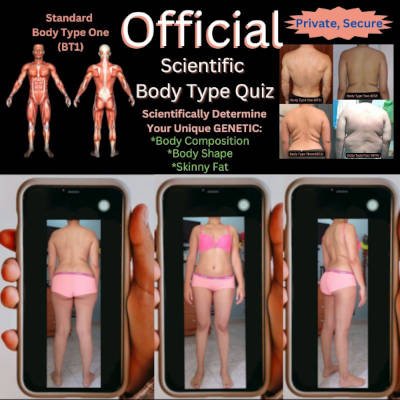 scan. A DEXA/DXA (23, 24, 25, 26, 27, 28, 29, 18) scan cannot accurately measure muscle mass or lack of (skinny fat), nor can any other lesser technology/means of measurement.
scan. A DEXA/DXA (23, 24, 25, 26, 27, 28, 29, 18) scan cannot accurately measure muscle mass or lack of (skinny fat), nor can any other lesser technology/means of measurement.
However, because MRI technology is relatively new, it is very expensive and hard to access for the vast majority of the population. Nonetheless, no substitute exists in terms of accuracy, at present. Our MRI Study (30) will validate our Scientific Body Type Quiz to give the average person globally a remote, cost-effective, user-friendly, secure, and private option to accurately assess skinny fat.
Research Participant 1170 – Skinny fat at Any Body Fat Percentage
Here is a classic example of skinny fat. See how Research Participant 1170 (31) is within safe BMI at 24.6 yet experiencing obvious skinny fat (normal weight obesity, cellulite, thin fat)(2):
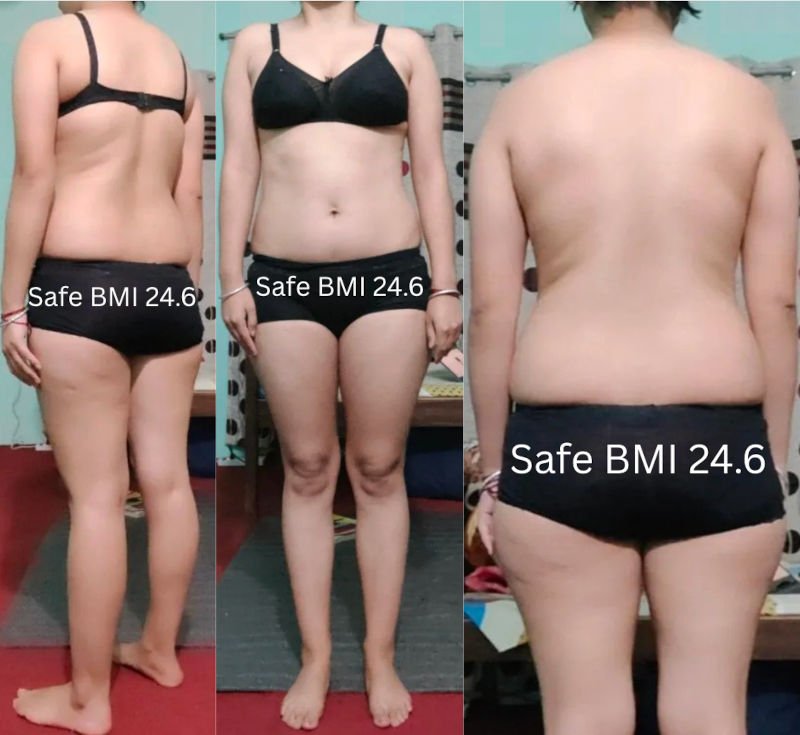
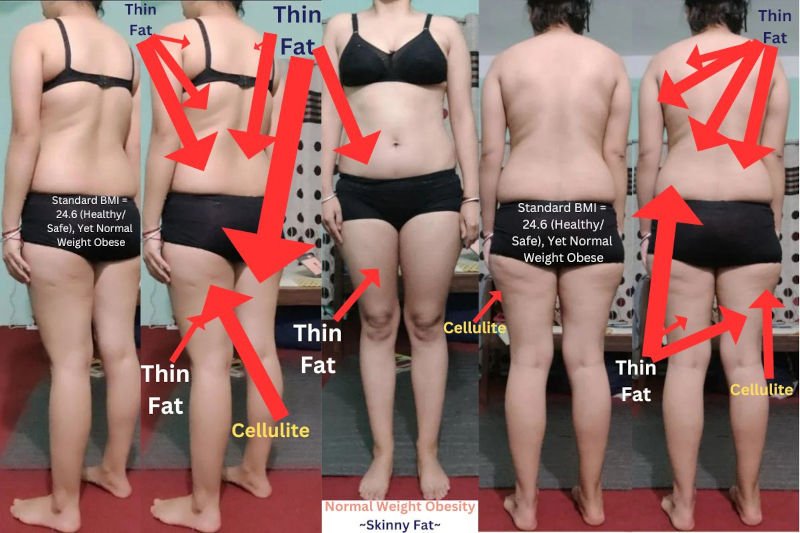
They are normal-weight obese and have thin fat and cellulite widespread across their body where they should have genetic default muscle tissue but do not. They lost regular white/yellow body fat (common adipose tissue, body fat %) down to BMI 21.3:
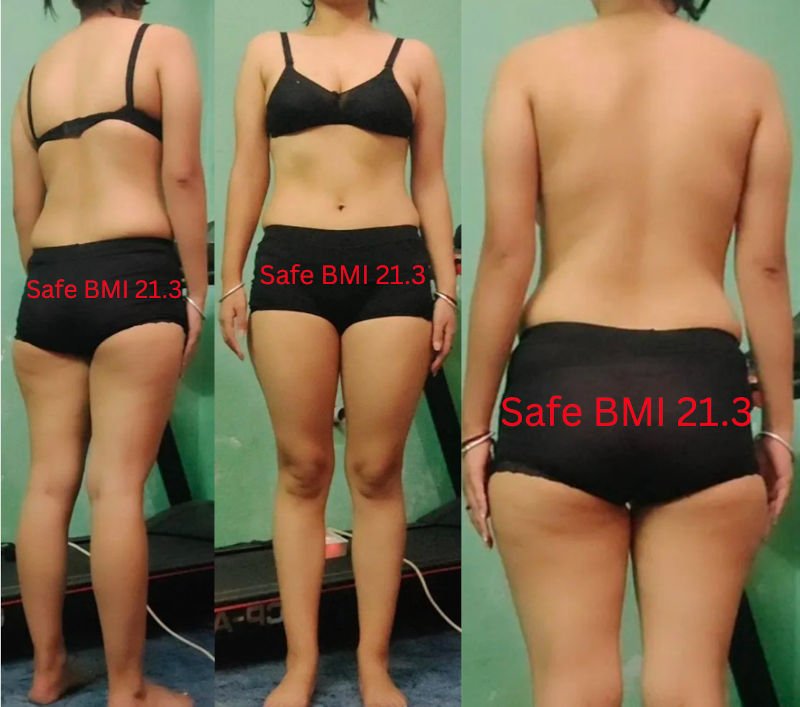
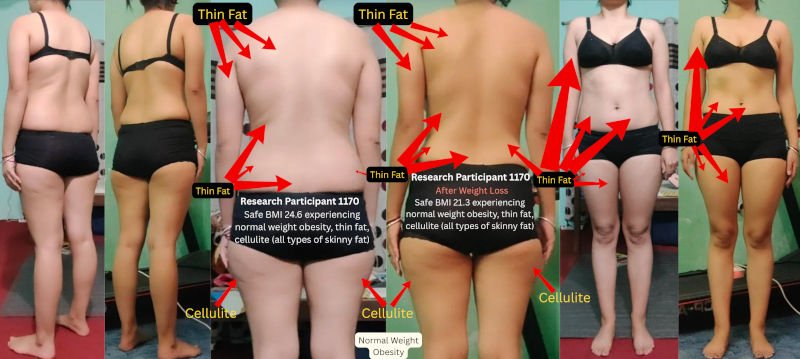
Yet, the skinny fat remains in all the same places where they should have genetic muscle tissue but do not.
If RP 1170 were to decrease their regular fat down to an underweight BMI of 18.49 or less, would the skinny fat go away??? No.
They would no longer be normal-weight obese. But, they would still be experiencing the thin fat and cellulite tissue widespread across their body where they should have genetic muscle tissue. The skinny fat (thin fat, cellulite) does not magically go away at BMI 18.49 or less.
If RP 1170 were to increase their regular fat to an excess overweight BMI of 25+ or 30+ obese, would the skinny fat go away??? No.
They would no longer be normal-weight obese. But, they would still be experiencing the thin fat and cellulite tissue widespread across their body where they should have genetic muscle tissue. The skinny fat (thin fat, cellulite) does not magically go away at BMI 25 or BMI 30 or beyond.
Skinny fat can exist at any BMI or body fat percentage. It is determined by a lack of genetic muscle tissue that is measured by a specific MRI scan (30). Our Scientific Body Type Quiz (Scientific Health Quiz App) gives anyone, anywhere, a safe, cost-effective, easy, private, and accurate new option to assess skinny fat.
References
- Britannica: human muscle system, Shane W. Cummings and Robin Huw Crompton (Fact-checked by the Editors of Encyclopaedia Britannica. https://www.britannica.com/science/human-muscle-system
- Skinny Fat Science: What Is Skinny Fat?, July 26, 2024. https://skinnyfat.fellowone.com/skinny-fat-science/what-is-skinny-fat/
- NIH, National Library of Medicine: Normal-weight obesity syndrome: diagnosis, prevalence, and clinical implications, September 2016 (Epub Jul 29, 2016), Lana P Franco, Carla C Morais, Cristiane Cominetti. https://pubmed.ncbi.nlm.nih.gov/27473199/
- Skinny Fat Science: Is Muscle/Mass Genetic and How Does It Affect Skinny Fat?, November 20, 2024. https://skinnyfat.fellowone.com/skinny-fat-science/is-muscle-mass-genetic-and-how-does-it-affect-skinny-fat/
- Skinny Fat Science: Is Skinny Fat Genetic?, November 27, 2024. https://skinnyfat.fellowone.com/skinny-fat-science/is-skinny-fat-genetic/
- Skinny Fat Science: Are Regular Fat and Skinny Fat the Same Thing?, August 28, 2024. https://skinnyfat.fellowone.com/skinny-fat-science/are-regular-fat-and-skinny-fat-the-same-thing/
- NIH, National Institute of Biomedical Imaging and Bioengineering: Magnetic Resonance Imaging (MRI), https://www.nibib.nih.gov/science-education/science-topics/magnetic-resonance-imaging-mri
- Johns Hopkins Medicine, Health: Magnetic Resonance Imaging (MRI), https://www.hopkinsmedicine.org/health/treatment-tests-and-therapies/magnetic-resonance-imaging-mri
- Cleveland Clinic: Magnetic Imaging Resonance (MRI), May 8, 2022. https://my.clevelandclinic.org/health/diagnostics/4876-magnetic-resonance-imaging-mri
- Mayo Clinic: MRI, September 9, 2023. https://www.mayoclinic.org/tests-procedures/mri/about/pac-20384768
- Wikipedia: Magnetic resonance imaging. https://en.wikipedia.org/wiki/Magnetic_resonance_imaging
- NIH, National Library of Medicine: Magnetic Resonance Spectroscopy: Principles and Techniques: Lessons for Clinicians, November 12, 2015, Joshua M Tognarelli, Mahvish Dawood, Mohamed IF Shariff, Vijay PB Grover, Mary ME Crossey, I Jane Cox, Simon D Taylor-Robinson, and Mark JW McPhail. https://pmc.ncbi.nlm.nih.gov/articles/PMC4723643/
- NIH, National Library of Medicine: Proton magnetic resonance spectroscopy for assessment of human body composition, February 2001, M Kamba 1 , K Kimura, M Koda, and T Ogawa. https://pubmed.ncbi.nlm.nih.gov/11157311/
- NIH, National Library of Medicine: Applications of the Dixon technique in the evaluation of the musculoskeletal system, January-February 2021, Carolina Freitas Lins, Carlos Ernesto Garrido Salmon, and Marcello Henrique Nogueira-Barbosa. https://pmc.ncbi.nlm.nih.gov/articles/PMC7869722/
- NIH, National Library of Medicine: FSE T2-weighted two-point Dixon technique for fat suppression in the lumbar spine: comparison with SPAIR technique, May 1, 2018, Sangmin Lee, Dae Seob Choi, Hwa Seon Shin, Hye Jin Baek, Ho Cheol Choi, and Sung Eun Park. https://pmc.ncbi.nlm.nih.gov/articles/PMC7869722/
- ScienceDirect: T2-weighted Dixon MRI of the spine: A feasibility study of quantitative vertebral bone marrow analysis, July–August 2021, Volume 102, Issues 7–8, Pages 431-438, Ricardo Donners, Anna Hirschmann, Andreas Gutzeit, and Dorothee Harder. https://www.sciencedirect.com/science/article/pii/S221156842100036X
- NIH, National Library of Medicine: MR-based assessment of body fat distribution and characteristics, August 2016, Thomas Baum, Christian Cordes, Michael Dieckmeyer, Stefan Ruschke, Daniela Franz, Hans Hauner, Jan S Kirschke, and Dimitrios C Karampinos. https://pubmed.ncbi.nlm.nih.gov/26905521/
- Nature, Scientific Reports: Changes in DXA-derived lean mass and MRI-derived cross-sectional area of the thigh are modestly associated, July 11, 2019, Dallin Tavoian, Kwasi Ampomah, Shinichi Amano, Timothy D. Law, and Brian C. Clark. https://www.nature.com/articles/s41598-019-46428-w
- NIH, National Institute of Biomedical Imaging and Bioengineering: Computed Tomography (CT), https://www.nibib.nih.gov/science-education/science-topics/computed-tomography-ct
- Mayo Clinic: CT scan. https://www.mayoclinic.org/tests-procedures/ct-scan/about/pac-20393675
- MedlinePlus, Medical Encyclopedia: CT scan. https://medlineplus.gov/ency/article/003330.htm
- NIH, National Institute of Biomedical Imaging and Bioengineering: Computed Tomography (CT), https://www.nibib.nih.gov/science-education/science-topics/computed-tomography-ct
- NIH, National Library of Medicine: Dual-Energy X-Ray Absorptiometry: Research Issues and Equipment, 1997, Wendy M. Kohrt. https://www.ncbi.nlm.nih.gov/books/NBK233779/
- Journal of Applied Physiology: Percent body fat via DEXA: comparison with a four-compartment model, February 1, 2003, Grant E. van der Ploeg, Robert T. Withers, and Joe Laforgia. https://journals.physiology.org/doi/full/10.1152/japplphysiol.00436.2002
- UC Davis Health, Sports Medicine: DXA body composition analysis, https://health.ucdavis.edu/sports-medicine/resources/dxa-info
- MedlinePlus: Bone Density Scan. https://medlineplus.gov/lab-tests/bone-density-scan/
- Cleveland Clinic: DXA Scan (Bone Density Test), May 28, 2024. https://my.clevelandclinic.org/health/diagnostics/10683-dexa-dxa-scan-bone-density-test
- Wikipedia: Dual-energy X-ray absorptiometry, https://en.wikipedia.org/wiki/Dual-energy_X-ray_absorptiometry
- NIH, National Library of Medicine: Comparison of DXA and CT in the Assessment of Body Composition in Premenopausal Women With Obesity and Anorexia Nervosa, March 25, 2013, Miriam A Bredella, Reza Hosseini Ghomi, Bijoy J Thomas, Martin Torriani, Danielle J Brick, Anu V Gerweck, Madhusmita Misra, Anne Klibanski, and Karen K Miller. https://pmc.ncbi.nlm.nih.gov/articles/PMC3607308/
- Skinny Fat Science: Scientific Skinny Fat MRI Study – Proving What Skinny Fat Is, March 25, 2025. https://skinnyfat.fellowone.com/skinny-fat-science/scientific-skinny-fat-mri-study-proving-what-skinny-fat-is/
- Fellow One Research: Body Type Test (Quiz) Results 1170 – Body Type Three (BT3) Female (Woman), Generation Z, February 2022. https://www.fellowone.com/fellow-one-research/the-four-body-types/body-type-quiz/body-type-test-quiz-results-1170-body-type-three-bt3-female-woman-generation-z/


